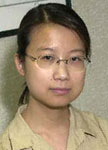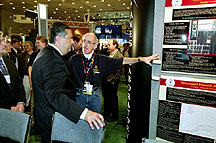Research
Highlights...
|
|
|
Jefferson
Lab's Xiaochao Zheng
|
|
 |
| Number 124 |
January 20, 2003 |
|
ADVISOR: Proper pressure saves fuel
Engineers at DOE's National Renewable
Energy Laboratory recently completed a series of simulations
for ADVISOR,
a hybrid electric vehicle simulation model, to be included in
the California Energy Commission's report on fuel-efficient tires.
The simulations used the new ADVISOR rolling resistance model
to show the impact of rolling resistance and tire pressure for
the fuel economy of a Ford Focus. Results show that purchasing
low rolling resistance tires and maintaining proper tire pressure
can provide significant fuel savings. The results are being included
in a report to the California legislature as part of Senate Bill
1170 on energy resource conservation.
[Sarah Holmes Barba, 303/275-3023,
sarah_barba@nrel.gov]
|
|
|
|
Clarifying Real Compton
Scattering
Physicists at DOE's Jefferson Lab
are busy analyzing data from their Real Compton Scattering experiment,
which explores the scattering of low-energy photons off the proton
at large scattering angles—where the quark structure of the
proton is expected to be revealed best. The experiment tests whether,
during scattering events, a photon bounces off a quark in the
way described by Arthur H. Compton for scattering from isolated
electrons, and as predicted by a JLab theorist. Or does the scattering
involve the cooperative behavior of three quarks, as predicted
by perturbative Quantum Chromodynamics? Preliminary results indicate
that protons are polarized along their line of momentum, confirming
the single-quark scattering mechanism advocated by JLab scientists.
[Debbie
Magaldi, 757/269-5102,
magaldi@jlab.org]
|
|
SLAC, Fermilab collaborate
on linac structure
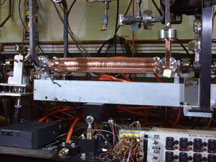 |
| Two-foot
long linear particle accelerator section |
In late 2002 a two-foot long linear particle accelerator section from
Fermilab arrived at DOE's Stanford
Linear Accelerator Center. It is one of the first fruits of
the collaboration between these two high-energy physics labs working
to design and build a proposed new collider. Their collaboration
is focused on learning to build accelerator sections in a manner
consistent with efficient industrial methods. The new collider would
need tens of thousands of these structures, so it would be necessary
to contract them out to industrial manufacturers for fabrication.
The Fermilab structure, and the dozen that will follow, will function
as a test and demonstration of the basic linac accelerator system
unit and of the international collaboration.
[Neil
Calder, 605/926-8707,
neil.calder@slac.stanford.edu]
|
|
Hardware enhances long-distance
collaborations
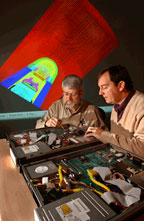 |
| Lyndon
Pierson (left) and Perry Robertson examine their groupís video
encoder and decoder. |
Near-real time interactive
remote-visualization hardware that enables people separated
by thousands of miles to share and collaborate on information
has been developed at DOE's Sandia
National Laboratories. Research team leader Lyndon Pierson
says the technology is expected to be of interest to oil companies,
universities, the military, medicine—"anywhere people have
huge quantities of visualization data to transmit and be jointly
studied." The hardware leverages advances in 3D commercial rendering
technology and compresses the video data flooding in at nearly
2.5 gigabits a second into a network pipe that carries less than
0.5 gigabits a second. It was demonstrated successfully in late
October between Chicago and Amsterdam.
[Howard
Kercheval, 505/844-7842,
hckerch@sandia.gov]
|
|
Engineer designs video
camera for response teams
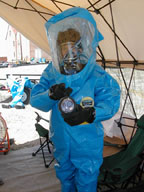 |
|
Hazmat
Cam
|
An engineer at the DOE's Idaho National
Engineering and Environmental Laboratory has designed a nifty
tool to help emergency response team members "see" a little better—the
Hazmat Cam. Hazmat Cam is a lightweight wireless video camera
system that emergency team members carry to the incident scene.
Housed in a tough, waterproof flashlight body, the camera system
sends back real-time images to a video monitor, or computer at
a command post located up to several miles from the incident area.
Hazmat Cam's true-diversity receiver seeks the strongest signal
from each of the three antennas. It completes this scan over 1,000
times per second, resulting in clear, more reliable image even
under less-than-perfect conditions.
[Kathy
Gatens, 208/526-1058,
kzc@inel.gov]
|
|
Determined
young woman enters world of sub-nuclear physics
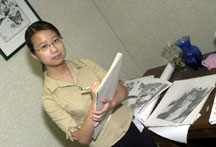 |
|
Xiaochao
Zheng is a prize-winning pen-and-ink artist and avid swimmer.
|
In China, completing middle and high school usually takes six
years, but Xiaochao Zheng finished a gifted program in just
four years; and at 14 entered a prestigious university. She
earned a bachelor's degree in engineering in 1996; then switched
to physics for her master's because she wanted more of a challenge.
She was accepted at the Massachusetts
Institute of Technology in 1999. During her second semester
she undertook the analysis of results from a Helium-4 experiment
conducted at Mainz, Germany. Within six months she learned about
a host of experimental details, and brought the data analysis
to the 90% completion point for publication, all while taking
a full load of graduate courses.
After only a year of classes she passed the written parts
of the doctoral qualification exam with flying colors, and set
about starting research for her thesis. She headed for DOE's
Jefferson Lab in June 2000
and quickly established herself as a determined and effective
student. She took on many night shifts on experiment data runs
to master the equipment she would use in her research, which
involved deeply inelastic scattering of polarized electrons
from polarized Helium-3. She familiarized herself with all aspects
of the experiment, tested and improved the target system, and
made valuable improvements to the laser and optics and electron
paramagnetic resonance polarimeter systems. During the four
month experiment run, Xiaochao played a key role in ensuring
data quality and in diagnosing experimental problems.
She completed her doctoral program in December 2002—a
breathtaking 3-1/4 years—and has accepted a post-doctoral
position at DOE's Argonne National Lab.
When asked about herself, Xiaochao said, "I'm just a plain
and shy person, but I would like to share the following saying
I try to follow: "Dream is not in the sky but in your heart.
Success is not on the ground but under your feet."
Submitted by DOE's Jefferson
Lab
|
|
